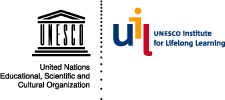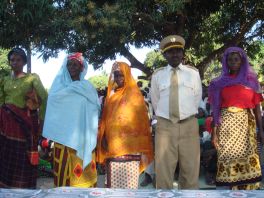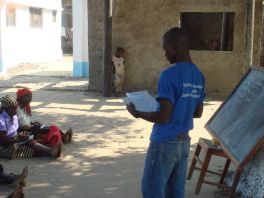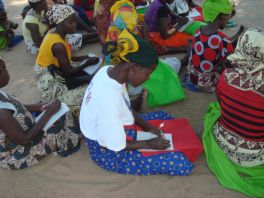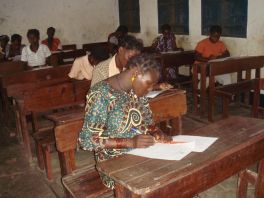Women’s Literacy in Angola and Mozambique
Country Profile: Mozambique
| Population | 25,824,000 (2013) |
|---|---|
| Official Language | Portuguese |
| Other recognised languages | Emakhuwa (25.3%), Xichangana (10.3%), other Mozambican languages (30.1%) |
| Poverty (Population living on less than 1.25 USD per day) | 59.6% (2011) |
| Total Expenditure on Education as % of GNP (2006) | 6.6% (2013) |
| Access to Primary Education – Total Net Intake Rate (NIR) | 87.4% (2013) |
| Total Youth Literacy Rate (15-24 years, 2009) | Total: 67.15% |
| Adult Literacy Rate (15 years and over, 2009) | Total: 50.58% |
| Statistical Sources |
Programme Overview
| Programme Title | Women’s Literacy in Angola and Mozambique (Alfabetizacao Feminina em Angola e Mocambique, FELITAMO) |
|---|---|
| Implementing Organization | DVV International, Associação Progresso, Movement for Educational for All (MEPT), African Women’s Development and Communication Network (FEMNET), and in Angola the Angolan Association for Adult Education (AAEA) |
| Language of Instruction | Portuguese and local languages |
| Funding | European Union and DVV International |
| Date of Inception | 2010 – (ongoing) |
Preliminary remark
Background and context
Mozambique is marked by a great number of long-lasting challenges. As a colony of Portugal for 470 years, this Sub-Saharan Africa country experienced a civil war (1975–1992) which started right after its independence and resulted in large-scale emigration to neighbouring nations and a great economic dependence on South Africa. Although there has been a substantive increase in the household income, financial asset-holding and the access to and quality of public services since the first free elections in 1994, the current (2011) unemployment rate is 21 per cent and over two-thirds of the population still live below the poverty line. In this low-income country, with an economy based on agriculture, forestry and fisheries, approximately 60 per cent of the population still resides in rural areas. The HIV/AIDS adult prevalence rate is 11.5 per cent (2009, estimated), which places Mozambique among the countries with the eighth highest rates in the world with approximately 1.4 million people facing this health condition.

Education constitutes another great challenge as it is characterised by significant gender and income inequalities. In 2009, net enrolment rate for boys stood at 93 per cent whereas for girls it equals 87 per cent. Also, there are about 30,400 more male than female new entrants to Grade 1 (2009). Gender disparities are due to a number of reasons, such as family values that do not place enough importance on their girls’ education and the great number of non-girl-friendly schools (e.g. public institutions which do not have separate toilets for girls). Adult literacy rates among men are almost twice as high than among women (70 per cent and 40 per cent, respectively, 2005–2008). Out of the total 5,759,000 adults who are illiterate, 69 per cent are women. For persons aged 15 to 24 years, the gender difference is 18 per cent favouring males. Inequalities in literacy rates are also found according to geographical location: there are 30.3 per cent of urban illiterates as opposed to 65.7 per cent of illiterates in rural areas; 15.1 per cent of the adult population of the southern province of Maputo does not master reading and writing, whereas 68.4 per cent residents of the northern province of Cabo Delgado face the same challenge (2004).
The current high illiteracy rates in Mozambique are not, however, only a result of poor early schooling. They are also a consequence of a lack of federal investments, since the importance of adult education was only recognised in 1975 after the country’s independence from Portugal. It was only then that nationwide adult literacy and educational campaigns were launched as well as education and training programmes, which resulted in a substantial increase in literate youths and adults – from 3 per cent to 28 per cent (1974–1982). Most recently, the federal government has given increasing attention to improving educational services for this target population through several initiatives, such as the 2001–2005 Action Plan for the Reduction of Absolute Poverty which has defined literacy and adult education as primary objectives among education programmes; and the National Strategy for Adult Literacy and Education and for Non-Formal Education (AEA/ENF) which was mainly designed to increase literacy rates in the country.
In the midst of these social and educational challenges FELITAMO is an innovative way to contribute to the government’s recent efforts of increasing the number of opportunities for providing and improving programmes for the development and enhancement of Mozambique’s human resources. This programme’s main course of action is not, however, direct implementation of educational opportunities. Rather, it is designed to enhance the delivery of services through the establishment of collaborative work among various organisations, provision of trainings and materials as well as the advocacy on the importance of education for women.
FELITAMO
The FELITAMO programme is a pioneer in its field as it has combined strong and across-sector partnerships among five non-governmental, regional and international stakeholders. Besides DVV International, whose main role has been to coordinate and lead the programme’s implementation, there are four other partners:
- Associação Progresso, a recipient of the 2005 UNESCO Literacy Prize aiming to reduce illiteracy rates at the village level in the Cabo Delgado province by providing a programme with a special focus on the use and instruction of local languages and by publishing materials for literacy classes in several local languages;
- the Movement for Education for All (MEPT, 1999), an advocacy movement initiated in 2008 in order to, among other objectives, increase awareness of the importance of educating women and providing them with literacy skills;
- the African Women’s Development and Communication Network (FEMNET), a non-profit organisation based in Kenya that promotes educational services throughout Africa; finally
- the Angolan Association for Adult Education (AAEA), which was established in 1998 with the primary objective of increasing educational provision to youths and adults in Angola through the use and expansion of an adapted version of the REFLECT methodology (Regenerated Freirean Literacy through Empowering Community Techniques).
This initiative also partners with local organisations that add expertise in specific areas, such as women’s associations which provide deep understanding about gender issues. In addition to the establishment of multiple partnerships, FELITAMO is marked by other great innovative characteristics. For instance, it promotes community involvement through the Community Literacy Forums aiming to empower members to take charge of the literacy classes and ownership of its implementation through managing and planning; and monitoring the process. Furthermore, this initiative has strongly recognised the importance of increasing the provision of educational opportunities for women and advocated for this, having identified the scarcity of rural women with sufficient schooling levels to become educators (only 30 per cent of the teaching workforce in primary schools is female, 2005) as well as there being a great gender gap in the access to education and mastering basic literacy and numeracy skills.
Aims and objectives
FELITAMO aims primarily to empower women in order to give this long-standing marginalised group an opportunity to rise out of poverty, improve their living conditions (i.e. health, education, housing and security), develop skills which will lead to the development of active citizenship and promote gender equality in society. Several specific objectives have been targeted in order to enable the organisation to reach this outcome. They are:
- to engage civic society in effective interventions to provide basic reading, writing and numeracy skills to female learners and professional development to female educators;
- to develop, implement and advocate for adult education models that are broad and innovative;
- to strengthen the capacity of civil society organisations to be better equipped to provide services on literacy as well as partnering with the government in order to maximise its resources;
- to strengthen partnerships among organisations that provide literacy classes across regions and countries;
- to enrich the materials for literacy classes in terms of quality, variety of languages and availability; and
- to improve the sharing and dissemination of best practices in the fields of literacy and adult education at regional, national and pan-African levels.
Programme implementation
FELITAMO has been implemented in Mozambique in two provinces: Cabo Delgado, the northernmost province of the country, in the districts of Mueda, Nangade and Muidumbe, and in the southern province of Nampula in the districts of Ilha de Moçambique and Nacaroa.

It also has a sister project in Angola, which has been implemented in the province of Kwanza Sul. The locations in both countries were selected according to the marked illiteracy rates among women: 83 per cent in Cabo Delgado, 81.4 per cent in Nampula and 77 per cent in Kwanza Sul. The activities promoted by this programme may differ in each region, but are mostly focused on:
- rolling out the provision of literacy classes;
- training and coaching literacy teachers and supervisors;
- organising literacy events (e.g. a reading contest among trainers);
- developing learning materials in Portuguese and local languages;
- providing professional development for trainers on gender mainstreaming;
- organising advocacy events (e.g. a 60-people event to exchange experiences about advocacy, gender and literacy)
- enabling experience exchanges between stakeholders from Angola and Mozambique; and
- developing and disseminating best practices (e.g. by way of a newsletter in the DVV International website).
Target population
The population targeted by FELITAMO uses a multilevel approach which includes not only the individuals who benefit from education services, but also those who are involved in the provision of such services. FELITAMO has reached the following groups:
- providers of adult education from non-governmental and non-profit organisations;
- decision- and policy-makers who are invited to participate in at least one activity aimed at strengthening collaboration, communication and information sharing such as panels, exchange visits and conferences;
- literacy educators and stakeholders in school governance who are selected to learn about gender perspectives in their work, to understand how to establish an appropriate environment for adult learning and to receive adequate training in adult education; and
- non-literate and semi-literate rural youths and adults 80 per cent of whom are females.
The participation of learners and literacy trainers varies in each region according to the organisation that heads the programme implementation. In Nampula, the first step is to identify where there are high rates of illiteracy among women so potential learners can be mobilised through community forums and by literacy trainers who invite their family members to join classes. They employ intergenerational learning in which trainers are school-age children who are recruited by school principals and community members in order to teach their own family members. Children are selected according to their high performance in school and the number of illiterate people in their families. In Cabo Delgado, recruitment of learners also take place in communities with high levels of illiteracy among women, but the recruitment is done through home visits and distribution of flyers that contain relevant information about the programme. Recruitment of trainers is made via the district offices of education, and it requires a trainer to have completed at least Grade 7.
Teaching/learning approaches and methodologies
The programme implemented by FELITAMO does not provide a framework to guide the teaching methodology to be used in the literacy classes with learners, but it does give support to the partner organisations to continue and/or improve their approach. It also promotes the exchange of knowledge among the different organisations in order to enable partners to exchange best practices and lessons learned. Some common features across partners include the use of participatory approaches that empower participants to be active learners and the flexibility of classes in which organisations consult with the communities about their preferences in terms of location and timetables.
Some locations implement specific methodologies, such as the Programme for Families without Illiteracy and HIV/AIDS, an intergeneration learning model being carried out in Nampula, where the literacy trainers are sixth and seventh graders. Another example is the Programme of Eradication of Illiteracy at Village-Level which focuses on improving literacy rates on specific villages that have high demand of literacy classes in the province of Cabo Delgado. Its greatest innovative feature is the use of local languages during teaching and learning activities in order to increase participation of students during classes.
Funding support
The total cost for this 3-year initiative equals EUR 1.100.000. Ninety per cent of this amount has been provided by the European Union under the programme named Investing in People-Gender Equality in Mozambique and Angola. The remaining ten per cent was financed by DVV International.
Monitoring and evaluation
FELITAMO has set specific goals to be accomplished by the end of the three-year plan, which are focused on (a) developing literacy skills in 6,000 youths and adults, 4,800 of whom will be women, (b) training 300 literacy facilitators (50 per cent of whom will be women), and (c) providing technical support to 30 trainers who will oversee the literacy facilitators (50 per cent of whom will be women). A mid-term monitoring assessment has recently (November 2011) been carried out and showed that 80 per cent of the planned intervention has already taken place. So far, the most outstanding activities have been the recruitment of trainers and the training of these facilitators. Also, the community forums have proven to be a great resource for community organising, empowering and producing a sense of ownership for participants becoming actively engaged in the implementation of literacy classes. The production and distribution of materials, in Portuguese as well as local languages, another key goal of this initiative, has been successfully achieved as both learners and trainers have received the necessary resources, albeit in limited quantities due to budgetary restrictions. Data collection for ongoing monitoring includes monthly logs kept by trainers and supervisors, community forums and programme visits done twice per year by coordinators.
To date, though no formal external evaluation has been carried out in order to assess the impact of the programme, many benefits have been observed and reported in three core domains since the programme’s inception. First, the social benefits refer to an improved equity of rights, especially with regard to gender issues. As FELITAMO’s work focuses on educational services which mainly target women, this initiative has provided this group with an opportunity to have access to life-changing experiences as they learn basic literacy and numeracy skills aimed at effecting a direct impact on their lives. This initiative has greatly contributed to changing the predominant male perception on female roles as mostly restricted to the performance of domestic chores and agricultural work in the communities where literacy classes are being provided. Second, considering that 20 per cent of households are headed by single mothers, economic benefits are a direct result of women acquiring literacy and numeracy skills since it enables them to buy and sell goods instead of being victims of extortion; they become able to negotiate prices and improve their employability. Finally, learners have also greatly benefited at the personal level. For instance, they can now read medicine prescriptions and feel a greater sense of empowerment in their social relationships within their families and communities as well as having more confidence and respect in dealing with men.
Challenges and lessons learned
Women are part of a social group that has been markedly marginalised in Mozambican society. This has led to a great number of women who experience many personal, social and economic struggles throughout their lives. Teen pregnancy, for instance, has been a major issue. The national rate of adolescent fertility, i.e. births per 1,000 women aged 15–19 years, equals 139 while the rate in its neighbouring country South Africa is 56 (2009). Also, the percentage of young women aged 15–24 with HIV (8.6 per cent, 2009) is almost three times higher than the rate among young men (3.1 per cent, 2009). The core idea behind FELITAMO’s initiative is to tackle these gender-related challenges by empowering women and increasing awareness of the major role women play in order to promote a sustainable development in society. Yet this issue also remains the biggest challenge the programme has had to face since its inception because many women have been prevented from attending classes on a regular basis in order to fulfil their very restricted female roles, such as doing domestic chores. This phenomenon has lead to high drop-out rates among female learners. Furthermore, since women have been historically left out of fully participating in the educational system, there are currently not enough female teachers in order to meet the programme’s goals with regard to offering professional development to this target group. Lastly, the male predominant mentality of excluding women from being active participants in society has greatly affected decision-makers in being more gender sensitive and issuing policies focusing on empowering women. Therefore, FELITAMO has made great efforts to advance in this matter by trying to increase the awareness of political leaders of the great positive impact resulting from capacitating female citizens.
The key lesson learned so far since the beginning of this initiative is about the importance of enabling community members to take ownership at various levels of the programme’s implementation as an effective way of building sustainable interventions. This has largely been carried out through the Community Literacy Forums where learners and members come together to discuss the design, development and specificities of the implementation of literacy classes in their midst. They also discuss ways of solving related problems, such as the lack of infrastructure for building a space for classes, finding solutions that do not solely rely on public funding but also count on the human and financial resources derived from their community.
Sustainability
FELITAMO has shown great levels of sustainability mainly through the fact the programme has been implemented in two different countries by a combination of regional and international cross-sector partnerships. Because of the remaining high gender inequalities experienced by many African countries, the need for such initiatives remains pressing. Thus, this three-year programme has set a great example for future actions aimed at empowering women with basic educational services. This is hopefully only a starting point for upcoming funding and actions to be carried out in the region.
Sources
- Mouzinho Mario ; Deborah Nandja: Literacy in Mozambique: Education for All Challenges. In:Adult Education and Development (2007), No. 67. [Available online]
- FELITAMO: Promovendo a Alfabetização de Mulheres em Angola e Moçambique. [Project description on DVV International website]
- Louise Fox: Beating the Odds: Sustaining Inclusion in Mozambique’s Growing Economy. Washington, D.C. : World Bank, 2008
Contact
Helder Fernandes Samo Gudo
Communication Officer
DVV International Mozambique
Av. Kwame Nkrumah, Ns, 1494, 2s Andar
Maputo, Mozambique
Tel.: +258 82 53 81 018
Email: User: helder.samogudo
Host: (at) gmail.com
Last update: 23 February 2012
